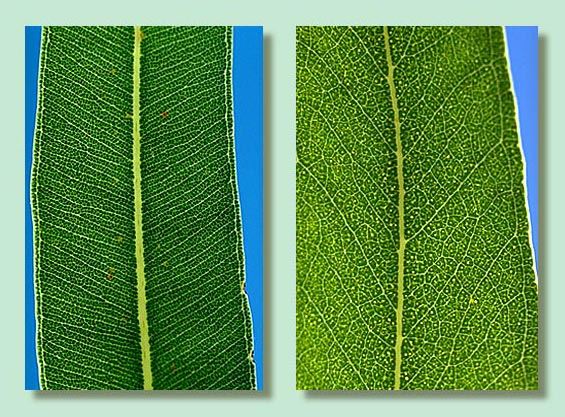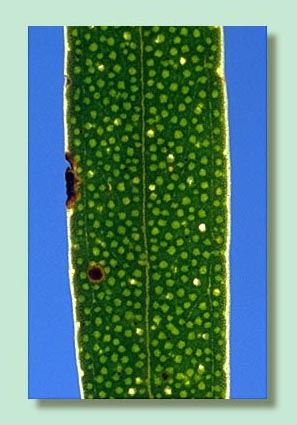Leaf venation consists of a midrib (the primary vein), the side or lateral veins (secondary veins) and veinlets (tertiary and quaternary veins) forming a network between the side-veins. The side-veins extend at an angle from the midrib out towards the leaf margin. In the great majority of species, the side-veins end at a vein running parallel to the leaf edge and just inside it or the vein is formed of loops connecting the ends of the side-veins. This is the intramarginal vein. In a few species (mostly desert bloodwoods), there is no detectable intramarginal vein and the side-veins run direct to the leaf edge. The pattern and density of the vein network and its relation to the position of the leaf oil glands is usually constant for species' groups. The side-veins (secondary veins) have varying degrees of minor, linking veining between them. These are the tertiary and quaternary veinlets.
Side-veins acute
The angle between the side-veins and the midrib is small. Many species of box (e.g. Eucalyptus largiflorens), stringybark (e.g. Eucalyptus macrorhyncha) and peppermint (e.g. E. andrewsii) are like this. Species in this category have a vein angle less than about 45 °. Assess mature adult leaves with a handlens whilst holding the leaf up to a strong light (sunlight is best).
Side-veins at an angle of greater than 45 ° to the midrib
The angle between the side-veins and the midrib is greater than 45 °, but less than a right angle. Bloodwood species (e.g. Corymbia terminalis) show the greatest angle of all species. Bloodwoods and some other species have leaves with regular, closely spaced side-veins at quite a wide angle - this is strictly called penniveined, meaning venation like a feather - the arrangement of midrib plus side-veins resembles a feather.
Parallel veined
The extreme condition is seen in the snow gums (e.g. E. pauciflora) and some peppermints (e.g. E. amygdalina) where the side-veins run parallel with the midrib, not sideways to the leaf edge.
Sde veins obscure or irregular
In many species a decision cannot be made about venation pattern because the side-veins are apparently absent. They do not show a distinctive penniveined or parallel pattern (e.g. E. cunninghamii), or are obscured by masses of oil glands (e.g. E. mimica).









